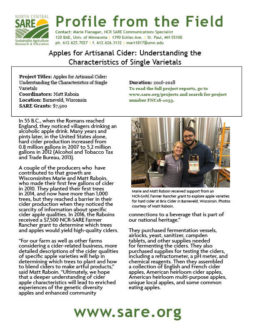In 55 B.C., when the Romans reached England, they noticed villagers drinking an alcoholic apple drink. Many years and pints later, in the United States alone, hard cider production increased from 0.8 million gallons in 2007 to 5.2 million gallons in 2012 (Alcohol and Tobacco Tax and Trade Bureau, 2013).
A couple of the producers who have contributed to that growth are Wisconsinites Marie and Matt Raboin, who made their first few gallons of cider in 2010. They planted their first trees in 2014, and now have more than 1,000 trees, but they reached a barrier in their cider production when they noticed the scarcity of information about specific cider apple qualities. In 2016, the Raboins received a $7,500 NCR-SARE Farmer Rancher grant to determine which trees and apples would yield high-quality ciders.
“For our farm as well as other farms considering a cider-related business, more detailed descriptions of the cider qualities of specific apple varieties will help in determining which trees to plant and how to blend ciders to make artful products,” said Matt Raboin. “Ultimately, we hope that a deeper understanding of cider apple characteristics will lead to enriched experiences of the genetic diversity apples and enhanced community connections to a beverage that is part of our national heritage."
They purchased fermentation vessels, airlocks, yeast, sanitizer, campden tablets, and other supplies needed for fermenting the ciders. They also purchased supplies for testing the ciders, including a refractometer, a pH meter, and chemical reagents. Then they assembled a collection of English and French cider apples, American heirloom cider apples, American heirloom multi-purpose apples, unique local apples, and some common eating apples.
They pressed and fermented all of the apples using the same methods (same yeast, same temperature, same yeast nutrients, etc.) to limit variables. Then they tested each juice and recorded specific gravity, total acidity, total tannins, and brix (a measurement of the approximate amount of sugars) for each. Each of the ciders went through a 3-week primary fermentation followed by a 6-week secondary fermentation. All of the ciders were then bottled and pasteurized.
They tasted the finished ciders and evaluated them, recording notes on color, aroma, multiple flavor components, and overall impression. The project is on-going, but so far, they have conducted fermentation experiments on more than 30 single varietal ciders to determine the cider qualities of each individual apple variety.
According to Matt Raboin, the brix of each cider ranged from 10.5 on the low end to 16.3 on the high end. Most of their favorite ciders were those on the higher end of the brix scale.
“There have been a few apples that were clear standouts compared with others and made very enjoyable ciders,” reported Raboin. “Some of our favorites thus far have included Yarlington Mill, Marin Oufroy, Wisconsin Russet, Black Gilliflower, Plumb Cider, and Minkler. This gives us some confidence that these may be apples that we would like to grow more of in the future.”
They are actively posting their results on their website www.brixcider.com, where visitors to the website can click on any of the apples they tested for more information.
For more information on Raboin’s NCR-SARE Farmer Rancher grant project, visit the SARE project reporting website or contact the NCR-SARE office.
View Matt Raboin's presentation on this project, from the 2018 Farmer's Forum, through NCR-SARE's Youtube playlist. Visit www.youtube.com/NCRSAREvideo for this and other videos.
